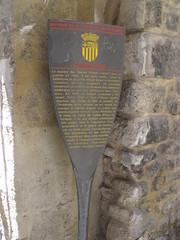Couvent des Grands Carmes
Couvent des Grands Carmes
(1359-present)
place, convent (1359-1825), and Carmelite convent (1359-1825)
Aged 666
Commemorated on 1 plaque
Passage Agard Le couvent des Grands Carmes s'établit dans ce quartier en 1359. Il fut saisi , vendu, divisé en habitations et en partie détruit durant la Révolution. Toutefois certains magasins du passage conservent sa mémoire et montrent des sculptures médiévales et des arcs gothiques dans leurs murs. En 1825 un temple protestant y fut ouvert. Entre 1846 et 1849 Félicien Agard, directeur des Salins du Midi et membre de l'Académie d'Aix racheta ce qui restait du couvent et décida d'ouvrir au public une communication entre le cours Mirabeau et la place du Palais de Justice (Place de Verdun). Il ne put réaliser entièrement son projet, face à l'opposition d'un propriétaire et la galerie se termine par un étroit goulot. Des boutiques, des imprimeurs et des ateliers s'installèrent dans cette nouvelle ruelle à l'aspect pittoresque et industrieux, désormais appelée Passage Agard.
English translation: Passage Agard Le convent des Grands Carmes settled in this area in 1359. It was seized, sold, divided into houses and partly destroyed during the Revolution. However, some shops of the passage retain its memory and show medieval sculptures and Gothic arches in their walls. In 1825 a Protestant temple was opened there. Between 1846 and 1849 Félicien Agard, director of the Salins du Midi and member of the Académie d'Aix, bought out what remained of the convent and decided to open to the public a communication between the Mirabeau course and the Place du Palais de Justice (Place de Verdun). He could not complete his project in the face of opposition from an owner and the gallery ended with a narrow gulf. Shops, printers and workshops set up in this new lane with a picturesque and industrial appearance, now known as Passage Agard. [AWS Translate]
Le Passage Agard - Cours Mirabeau, Aix-en-Provence, France where it was

